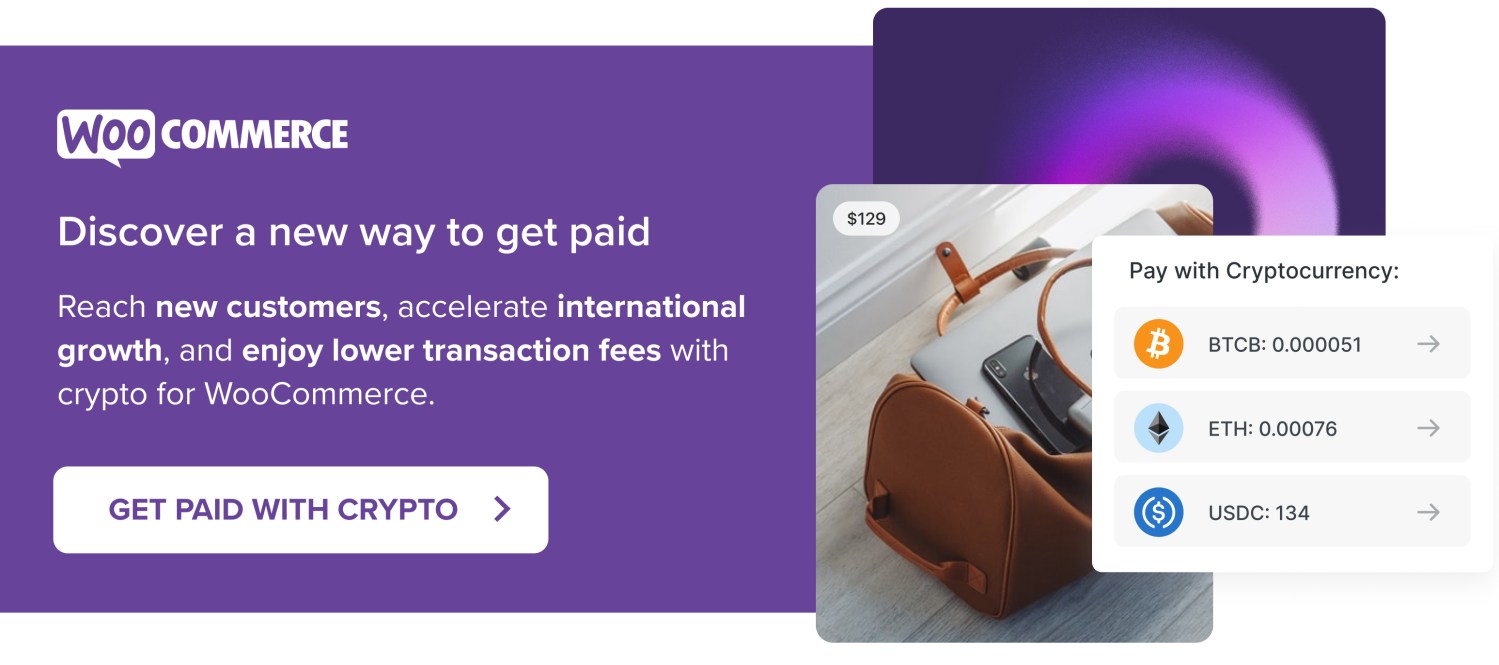The digital realm continues to pervade and disrupt the way we live our lives. The digitization of financial resources is no exception. Woo has offered cryptocurrency payment solutions through our select partners since 2022. Since then we’ve been working to expand our support for digital assets for Woo merchants.
This blog post aims to introduce Woo merchants, builders, and customers to the world of digital wallets and assets. We’ll unravel their essence, significance, and practical applications. In subsequent posts, we’ll explore how Woo merchants are using NFTs (and other digital assets) for fun and profit and what to consider if you’re trying to select an NFT solution for your Woo store.
Digital wallets: The basics
↑ Back to topWhat do you keep in your physical wallet (or purse)? Probably some cash, some debit/credit cards, some kind of identity card like a driving license, maybe a membership card or two, maybe some receipts and maybe a photo of your family or a treasured note.
A digital wallet is designed to hold the digital equivalents of all of those. They’re flexible pieces of software and connected tools that can hold and display a diverse array of digital assets, including cryptocurrencies like Bitcoin and Ethereum, as well as non-fungible tokens (NFTs). Whilst this article focuses on cryptocurrency-powered digital assets, it’s worth noting that digital wallets are also used for Central Bank Digital Currencies and indeed any kind of digital currency or asset.
As explored in this post, it’s important to note that there are two key types of digital wallet available:
- Custodial wallets are made available to you by a service provider. If you buy crypto on an exchange like Coinbase, Kraken, or Binance, they’ll deposit that crypto into an account they provision and manage on your behalf. PayPal, Google Pay and Apple Wallet are also examples of custodial digital wallets.
- Non-custodial wallets are those which you can solely control — no other person or entity can authorize transactions unless you let them. Most crypto exchanges now also offer their own non-custodial wallet solution too but other popular crypto wallets include MetaMask, Rabby and Rainbow.
And of course because they’re software, they just live as an app on your phone or a browser extension!
Benefits of digital wallets
↑ Back to topDigital wallets’ utility extends far beyond mere convenience:
- Enhanced security: Comprehensive security features allow you to safeguard your digital assets from online threats. Like any digital system, security is a practice rather than a task and finding the balance of convenience, security and privacy that’s right for you is key.
- Streamlined transactions: Digital wallets revolutionize online purchases and asset transfers, making them a breeze. For instance, PayPal’s digital wallet facilitates seamless transactions in various cryptocurrencies or fiat currencies from a single interface.
- Digital investment gateway: Possessing a digital wallet is the gateway to the digital economy, empowering you to engage in trading and investing in digital assets including cryptocurrencies and NFTs but also in stocks, ETFs and any other digital financial resource that is available to you.
- Enhanced customer experiences: Businesses can use digital wallets to create personalized shopping experiences, loyalty programs, and exclusive access to products and services. We can see a contemporary example of this with Nike’s .swoosh program but in fact any digital loyalty program requires digital wallets — from Starbucks points to airline frequent flier programs.
- Streamlined payments: Consumers can use digital wallets to make quick and secure payments for goods and services both online and in-store. Likewise, merchants can receive and store all their payments and assets in their own digital wallets — including digital goods for sale.
Acquiring a digital wallet
↑ Back to topWhether you’re a merchant or customer, you may find yourself wanting or needing a digital wallet. We don’t usually think of merchants needing a wallet but really a cash register or point of sale system is just a specialized type of wallet. Obtaining a digital wallet is a straightforward process. We’re only going to cover the high level process here as it’ll vary depending on which wallet you choose.
- Wallet Selection: Choose between hardware wallets like Ledger for non-custodial security and software wallets like the custodial Coinbase app for ease of use and accessibility. Increasingly though, brands are providing wallets that are tied to existing accounts or tools that require no specialist knowledge or setup. For example, there are now tools that let you use a crypto account by using a typical email and password sign in or even just by clicking a unique web link.
- Account Setup: For a custodial wallet, you’ll follow the provider’s instructions to establish an account, typically involving secure login credentials and, in some cases, identity verification. For a non-custodial wallet you’ll need to securely record a private key – usually in the form of a seed phrase.
- Security Fortification: Implement robust security measures like two-factor authentication and secure backups to safeguard your digital assets. Most importantly, educate yourself about cybersecurity and understand the risks associated with using digital wallets. Unlike traditional payments, there is usually no recourse if you send funds to an incorrect address or your wallet gets hacked.
Using digital wallets
↑ Back to top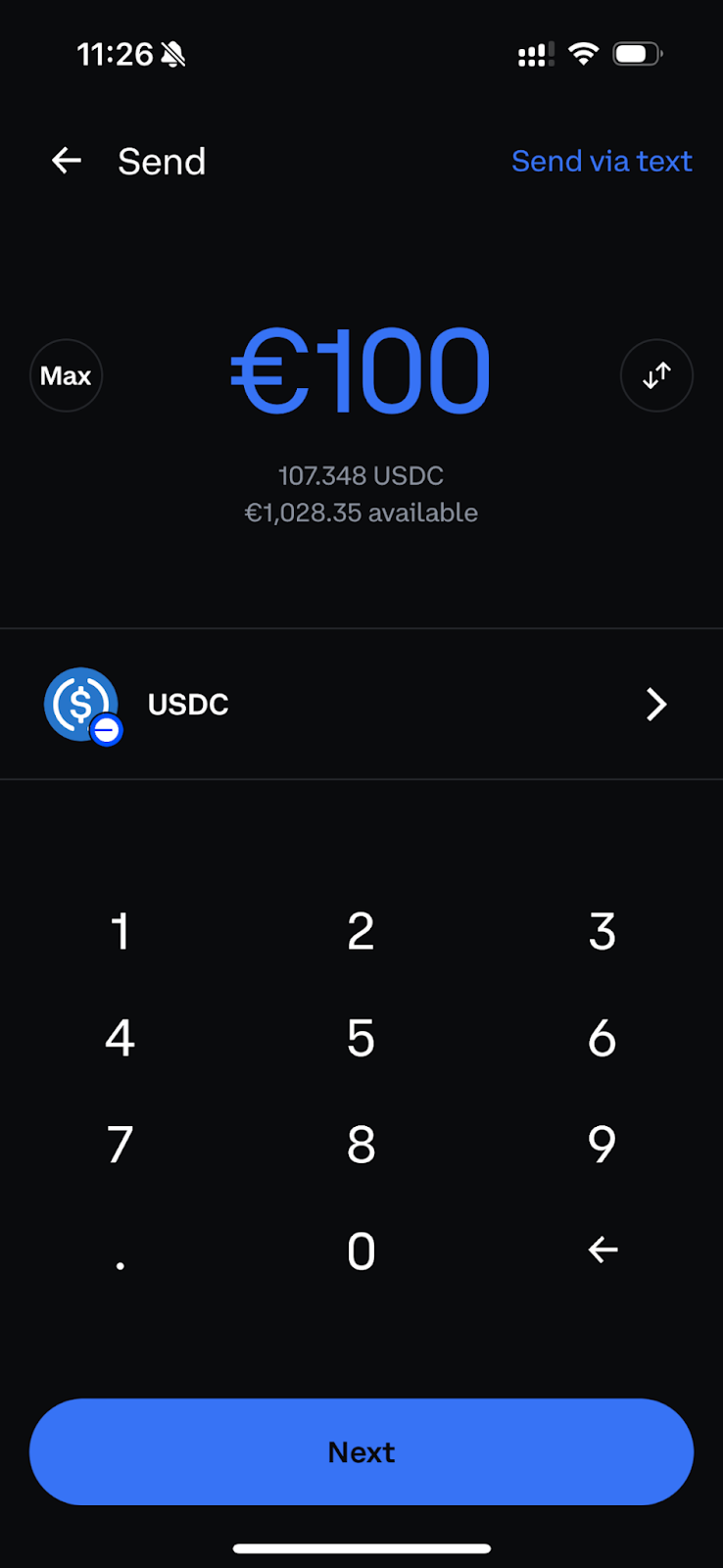
Effectively utilizing a digital wallet involves the following steps:
- Wallet funding: You can transfer digital currencies from another wallet or purchase them using fiat currencies. For instance, Coinbase allows you to purchase cryptocurrencies using credit cards or bank transfers.
- Transaction execution: To make a transfer, enter the recipient wallet address and the desired amount and authorize using the wallet-specific interface. Transactions are typically confirmed within minutes. User journeys for minting NFTs or making trades are similar — all are often initiated using QR codes or links because digital wallet addresses are not easily memorable!
- Asset management: Monitor your digital assets regularly, track their value, and make informed decisions about your holdings.
- Tax liabilities: Don’t forget that digital assets are subject to regulations in most jurisdictions. Be aware of how using digital assets can affect your tax liabilities and make sure you can file and pay your taxes as appropriate!
Digital assets
↑ Back to top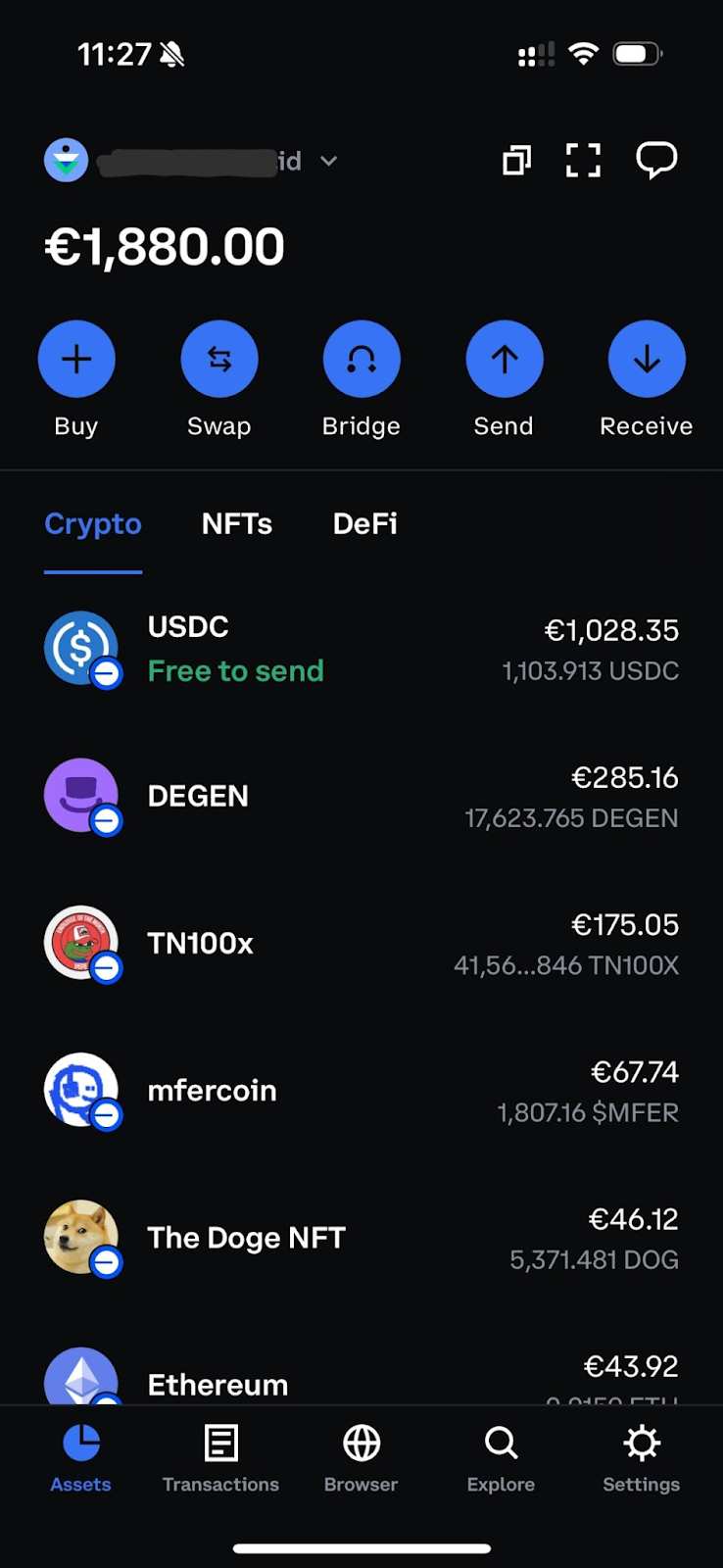
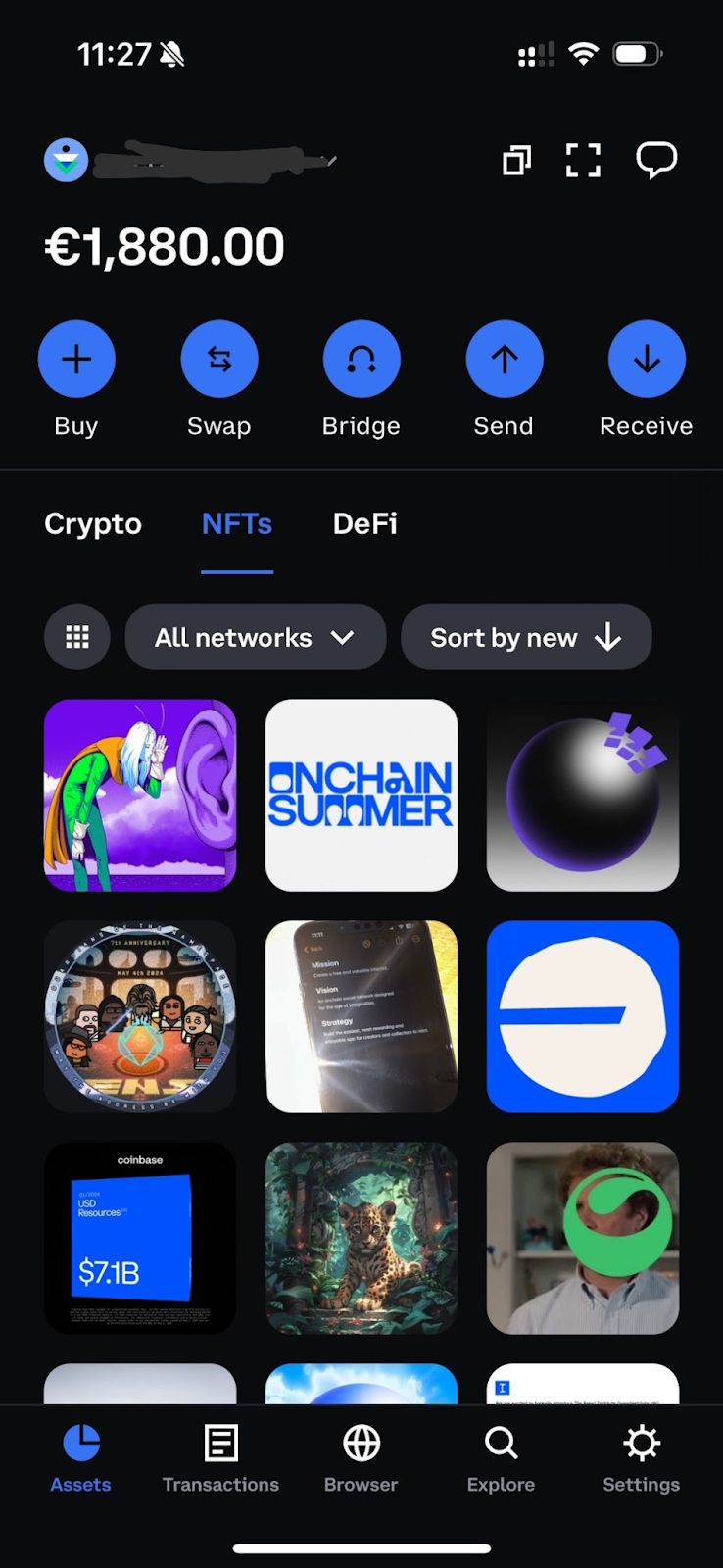
Digital assets encompass a vast spectrum of electronically stored data, ranging from cryptocurrencies to digital rights and Non-Fungible Tokens (NFTs). Your digital wallet could contain an assortment of the following digital assets:
- Cryptocurrencies
These digital or virtual currencies leverage cryptography for security. Bitcoin, the pioneer and most widely recognized cryptocurrency, revolutionized the concept of decentralized currency. - Digital rights and access tokens
This category encompasses digital tokens representing ownership or access rights. For instance, utility tokens on platforms like Ethereum grant access to specific services or benefits. - NFTs: The non-fungible revolution
Non-Fungible Tokens (NFTs) represent unique digital assets that embody ownership of a specific item or piece of content, typically stored on a blockchain. Unlike cryptocurrencies, NFTs are non-interchangeable, each possessing unique characteristics. For example, an NFT could represent ownership of a digital artwork, such as Beeple’s “Everydays: The First 5000 Days,” which sold for over $69 million. The uses of NFTs are as wide as your imagination but in the next post we’ll look at some use cases specific to Woo merchants.
NFTs grew to fame on Ethereum but are now supported by all major blockchains, although the terminology can change. - Memecoins
One of the key crypto trends of 2023/2024 has been the explosion of memecoins. These are projects that don’t pretend to have any initial fundamental value or utility. Their only initial value lies in the community around the meme, although sometimes memecoins do then go on to attempt to build something tangible based on the capital raised.
Brands leading the web3 revolution
↑ Back to top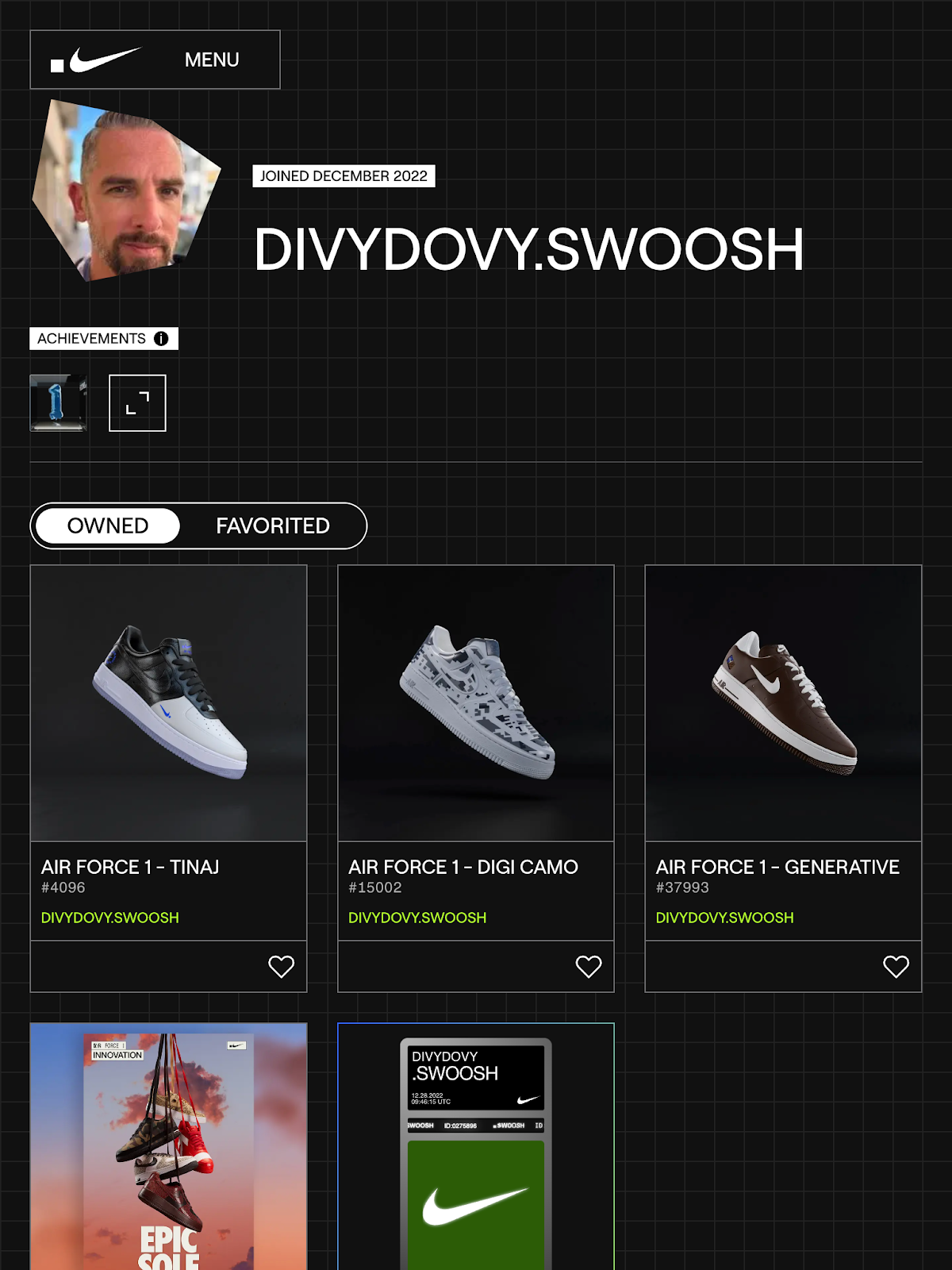
Several forward-thinking brands are embracing web3 digital wallets to create innovative and engaging customer experiences:
- Nike: Nike is utilizing web3 digital wallets to build a more immersive and personalized shopping experience. The brand has partnered with blockchain companies to develop a platform where customers can buy, sell, and trade digital sneakers. Nike is also employing web3 digital wallets to offer exclusive access to products and experiences for its loyal customers.
- Adidas: Adidas is another major brand that is embracing web3 digital wallets. The company has created its own digital wallet, called Adidas Originals Gateway, which allows customers to buy, sell, and trade NFTs. Adidas is also using web3 digital wallets to create a loyalty program that rewards customers for engaging with the brand on social media and in the metaverse.
- Louis Vuitton: Louis Vuitton is using web3 digital wallets to create a more exclusive and luxurious shopping experience for its customers. The company has partnered with several blockchain companies to develop a platform where customers can buy, sell, and trade digital handbags and other accessories. Louis Vuitton is also using web3 digital wallets to provide access to exclusive events and experiences for its VIP customers.
- Coca-Cola: Coca-Cola is using web3 digital wallets to create a more engaging and interactive marketing experience for its customers. The company has created a series of NFTs that can be redeemed for physical products or digital experiences. Coca-Cola is also using web3 digital wallets to run contests.
- McDonald’s: McDonald’s is using web3 digital wallets to create a more personalized and rewarding experience for its customers. The company is working with several blockchain companies to develop a platform that allows customers to earn points for purchases, which can then be redeemed for discounts or other rewards. McDonald’s is also using web3 digital wallets to provide exclusive access to promotions and events.
These are just a few examples of how brands are using web3 digital wallets to create new and innovative experiences for their customers. As web3 technology continues to evolve, we can expect to see even more creative and groundbreaking applications of these wallets in the years to come.
Digital wallets align with Woo values
↑ Back to topDigital wallets and digital assets align with the core values of WordPress and Woo: openness, freedom, and community. We know these values matter to Woo merchants.
- Openness: Cryptocurrencies are not just open source, they’re open state and open access. That means that anyone can build and collaborate with anyone else, freely and without permission. We’ll cover some examples of how this can be powerful in our next post in this series.
- Freedom: Digital wallets and digital assets extend the freedom that Woo gives you to sell and adds the ability to send and receive digital currencies and assets, globally, cheaply and programmably. In short, where Woo allows you to sell anything, NFTs allow you to sell scarce, programmable digital assets and digital payments infrastructure allows you to accept payments for it.
- Community: NFTs can be used to create exclusive communities for artists, collectors, and fans. Every time a crypto transaction happens, it creates a permanent record that is open for all to see. These tie together participants and create the substrate for community and collaborative innovation.
Digital wallets and assets for Woo merchants
↑ Back to topAs Woo embraces NFT and token-gating solutions, understanding digital wallets and the diverse landscape of digital assets becomes increasingly important for merchants and their customers. These technologies not only facilitate transactions but also redefine the realm of digital ownership and expand the creative space that commerce can occupy. Stay tuned for the next post in this series, where we’ll explore more specific use cases for Woo merchants and then discuss requirements that Woo merchants might want to consider when selecting an NFT solution for their store.
About


